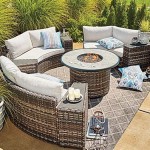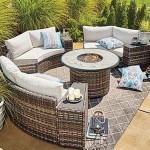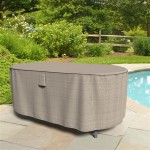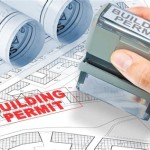Outdoor Patio Ideas Around Pool Area
The allure of a swimming pool extends beyond the refreshing water it holds. The surrounding patio area serves as an integral component, transforming a simple pool into an outdoor oasis. This space provides functionality for relaxation, entertainment, and dining. Thoughtful design and strategic implementation of materials and features can significantly enhance both the aesthetic appeal and usability of the pool area.
Planning an outdoor patio around a pool involves careful consideration of several factors, including space availability, budget constraints, desired aesthetic, and local climate conditions. The patio must complement the pool's design while offering a comfortable and safe environment for users. Addressing these aspects during the planning phase can prevent costly revisions later on.
Material selection plays a crucial role in determining the durability, maintenance requirements, and overall look of the patio. Several options are available, each with its own set of advantages and disadvantages. Concrete, pavers, natural stone, and composite decking are among the most popular choices. The chosen material should be slip-resistant, weather-resistant, and able to withstand the constant exposure to water and chemicals associated with a pool environment.
Beyond the surface material, the layout and design of the patio contribute significantly to its functionality and aesthetic appeal. Considerations include the size and shape of the patio, the placement of furniture and accessories, and the integration of landscaping elements. A well-designed patio should provide Ample space for sunbathing, dining, and lounging, while also creating a visually appealing and inviting atmosphere.
Material Selection for Pool Patios
The selection of patio materials is a fundamental decision impacting the longevity, safety, and aesthetics of the pool area. Each material offers distinct properties that cater to different needs and preferences. Understanding the characteristics of each option allows for informed choices based on specific requirements.
Concrete: Concrete remains a widely used option due to its versatility and affordability. It can be poured and shaped into various forms, allowing for customization and integration with the pool's design. Concrete can also be stained, stamped, or textured to mimic the look of more expensive materials. However, concrete is prone to cracking over time, especially in areas with significant temperature fluctuations. Regular sealing is necessary to prevent staining and water damage. Its relatively high heat retention can also be a disadvantage in hot climates, requiring lighter colors or shading solutions to mitigate the issue.
Pavers: Pavers offer a balance of durability, aesthetics, and ease of installation. They come in a variety of shapes, sizes, colors, and materials, including concrete, brick, and natural stone. Pavers provide a more textured surface than poured concrete, offering better slip resistance. They are also less prone to cracking and can be easily replaced if damaged. Paver installation typically requires a compacted base of gravel and sand, which adds to the overall cost. However, the long-term benefits of pavers, such as their durability and low maintenance, often outweigh the initial investment.
Natural Stone: Natural stone, such as flagstone, travertine, and slate, provides a luxurious and natural aesthetic. Each stone piece is unique, adding character and visual interest to the patio. Natural stone is highly durable and weather-resistant, making it a suitable choice for pool areas. However, natural stone can be more expensive than concrete or pavers. Installation also requires specialized skills and equipment. Some types of natural stone can become slippery when wet, so choosing a textured or honed finish is crucial for safety.
Composite Decking: While traditionally used for decks, composite decking is becoming increasingly popular for pool patios. It is made from a blend of wood fibers and recycled plastic, offering the look of wood without the maintenance requirements. Composite decking is resistant to rot, decay, and insect damage. It is also slip-resistant and stays cooler than concrete or natural stone in direct sunlight. However, composite decking can be more expensive than other materials. It may also fade over time, although newer generations of composite decking are more resistant to fading.
Beyond these primary materials, alternative options such as gravel, decomposed granite, and rubber surfacing can be considered for specific areas of the patio. Gravel and decomposed granite offer a natural and permeable surface, while rubber surfacing provides a soft and slip-resistant surface, ideal for children's play areas.
Designing for Functionality and Aesthetics
Effective patio design transcends material selection; it involves organizing the space to maximize functionality and create a visually appealing environment. This process entails considering the layout, furniture placement, landscaping, and integration of features that enhance the user experience.
Layout Considerations: The layout of the patio should be dictated by the size and shape of the space, as well as the intended uses. Separate zones for different activities, such as dining, lounging, and sunbathing, can improve functionality. Ample circulation space is essential to ensure comfortable movement throughout the patio. Consider designing the patio with a focal point, such as a fire pit, water feature, or pergola, to draw the eye and create a sense of visual interest. The proximity of the patio to the pool should also be considered, with adequate space for entering and exiting the pool safely.
Furniture Placement: The selection and placement of furniture are crucial for creating a comfortable and inviting patio. Choose furniture that is weather-resistant and easy to clean. Consider the size and scale of the furniture in relation to the overall space. Arrange furniture in a way that encourages conversation and interaction. Include ample seating options, such as lounge chairs, sofas, and dining sets. Provide shade options, such as umbrellas or pergolas, to protect from the sun's harmful rays. Consider incorporating outdoor rugs to define seating areas and add warmth and texture to the patio.
Landscaping Integration: Landscaping plays a vital role in softening the hardscape of the patio and creating a more natural and inviting atmosphere. Incorporate plants that are well-suited to the local climate and require minimal maintenance. Consider using drought-tolerant plants to conserve water. Create privacy screens using hedges, trees, or climbing plants. Add pops of color with flowering plants. Consider incorporating a vertical garden to add visual interest and create a green wall. Use potted plants to add flexibility and allow for seasonal changes. Proper irrigation is essential to ensure the health and vitality of the landscaping.
Feature Integration: Integrating features such as fire pits, water features, outdoor kitchens, and lighting can significantly enhance the functionality and aesthetic appeal of the patio. A fire pit provides warmth and ambiance, extending the usability of the patio into the cooler months. A water feature adds a calming and relaxing element to the space. An outdoor kitchen allows for convenient meal preparation and entertaining. Lighting enhances the ambiance of the patio and provides safety and security. Consider incorporating string lights, pathway lights, and spotlights to create a warm and inviting atmosphere. Smart home technology can be integrated to control lighting, sound, and other features from a smartphone or tablet.
Furthermore, consider the accessibility of the patio for individuals with mobility limitations. Ramps or gradual slopes can provide easier access for wheelchairs and other mobility devices. Ensure that pathways are wide enough to accommodate wheelchairs and that furniture is arranged to allow for easy maneuverability.
Maintaining Safety and Durability
Maintaining the safety and durability of a pool patio is essential for preserving its aesthetic appeal and ensuring the well-being of its users. Regular cleaning, preventative maintenance, and prompt repairs can significantly extend the life span of the patio and prevent accidents.
Regular Cleaning: Regular cleaning is crucial for removing dirt, debris, and algae that can accumulate on the patio surface. Sweep or blow off the patio regularly to remove loose debris. Wash the patio with soap and water to remove dirt and stains. Use a pressure washer to remove stubborn stains and algae, but be careful not to damage the surface of the patio. Consider using a specialized patio cleaner to remove specific types of stains, such as oil or grease.
Preventative Maintenance: Preventative maintenance can help to prevent damage and extend the lifespan of the patio. Seal concrete and natural stone patios to protect them from staining and water damage. Repair cracks and chips in concrete and pavers promptly to prevent further damage. Inspect and repair grout lines between pavers to prevent weeds from growing. Trim landscaping to prevent it from encroaching on the patio. Clean gutters and downspouts to prevent water from pooling on the patio.
Safety Considerations: Safety should be a top priority when maintaining a pool patio. Ensure that the patio surface is slip-resistant, especially when wet. Install railings around elevated areas to prevent falls. Provide adequate lighting to prevent accidents at night. Keep the patio free of clutter and tripping hazards. Supervise children around the pool and patio at all times. Post warning signs to remind users of safety precautions. Consider installing a pool fence to prevent unauthorized access to the pool area.
Addressing drainage issues is also a crucial aspect of maintaining the patio's integrity. Proper drainage prevents water from pooling on the surface, which can lead to slippery conditions, algae growth, and structural damage. Ensure that the patio is sloped away from the pool and house to facilitate water runoff. Install drainage systems, such as French drains or channel drains, to collect and redirect excess water. Regularly inspect and clean drainage systems to prevent clogs.
By implementing these maintenance and safety measures, the pool patio can remain a safe, attractive, and functional space for relaxation and entertainment for years to come. The ongoing attention to detail ensures a welcoming environment that enhances the overall enjoyment of the pool area.

House Home 18 Pool Patios You Ll Want To Hang Out On All Summer Long

Top 6 Pool Deck Patio Design Ideas Luxury Pools Outdoor Living

Inspiring Outdoor Patio And Pool Decks Image Gallery Find Design Ideas Inspiration

Outdoor Patio Decorating Ideas The Pool Reveal Curls And Cashmere

Top 18 Poolside Decorating Ideas For A Backyard Oasis Decorilla Interior Design

Backyard Design

16 Backyard Pool Ideas Visualized Brick Batten

Top Pool Deck Design Ideas Landscaping Kitchen Allegheny Butler Westmoreland Pa The Blackwood Group

Backyard Pool Pergola Ideas

Top 18 Poolside Decorating Ideas For A Backyard Oasis Decorilla Interior Design
See Also








